Set up an Application Developers Controlled Distribution (ADCD) in IBM zD&T v1
You can run an IBM Z Development and Test Environment (zD&T) environment on Azure Virtual Machines (VMs). This environment emulates the IBM Z Series architecture. It can host a variety of Z Series operating systems or installations (also called Z Instances or Packages), which are made available through customized bundles called the IBM Application Developers Controlled Distributions (ADCDs).
This article shows you how to set up an ADCD instance in a zD&T environment on Azure. ADCDs create complete Z Series operating system implementations for development and testing environments that run in zD&T.
Like zD&T, ADCDs are available only to IBM customers and partners and are exclusively for development and testing purposes. They are not to be used for production environments. Numerous IBM installation packages are available for download through Passport Advantage or IBM PartnerWorld.
Prerequisites
An Azure subscription. If you don't have one, create a free account before you begin.
The zD&T environment previously set up on Azure. This article assumes that you are using the same Ubuntu 16.04 VM image created earlier.
Access to the ADCD media through IBM PartnerWorld or Passport Advantage.
A licensing server. This is required to run IBM zD&T. The way you create it depends on how you license the software from IBM:
Hardware-based licensing server requires a USB hardware device that contains the Rational Tokens necessary to access all portions of the software. You must obtain this from IBM.
Software-based licensing server requires you to set up a centralized server for the management of the licensing keys. This method is preferred and requires you to set up the keys you receive from IBM in the management server.
Download the installation packages from Passport Advantage
Access to the ADCD media is required. The steps below assume you are an IBM customers and can use Passport Advantage. IBM partners can use IBM PartnerWorld.
Note
This article assumes that a Windows PC is used to access Azure portal and to download the IBM media. If you are using a Mac or Ubuntu desktop, the commands and process for obtaining the IBM media may differ slightly.
Log on to Passport Advantage.
Select Software Downloads and Media Access.
Select Program offering and agreement number, and click Continue.
Enter the part description or part number, and click Finder.
Optionally, click the alphabetical order list to display and view the product by name.
Select All Operating Systems in the Operating system field, and All Languages in the Languages field. Then, click Go.
Click Select individual files to expand the list and display the individual media to download.
Verify the package(s) that you want to download, select Download, and then download the files to the directory you want.
Upload the ADCD package(s)
Now that you have the package(s), you must upload them to your VM on Azure.
In the Azure portal, initiate a ssh session with the Ubuntu VM you created. Go to your VM, select the Overview blade, and then select Connect.
Select the SSH tab, and then copy the ssh command to the clipboard.
Log on to your VM using your credentials and the SSH client of choice. This demo uses the Linux extensions for Windows 10, which adds a bash shell to the Windows command prompt.
When logged on, create a directory to upload the IBM packages. Keep in mind Linux is case sensitive. For example, this demo assumes the packages are uploaded to:
/home/MyUserID/ZDT/adcd/nov2017/volumesUpload the files using an SSH client such as WinSCP. Since SCP is a part of SSH , it uses port 22, which is what SSH uses. If your local computer is not Windows, you can type the scp command in your SSH session.
Initiate the upload to the Azure VM directory you created, which becomes the image storage for zD&T.
Note
Make sure that ADCDTOOLS.XML is included in the upload to the home/MyUserID/ZDT/adcd/nov2017 directory. You will need it later.
Wait for the files to upload, which may take some time depending on your connection to Azure.
When the uploads are complete, navigate to the volumes directory and decompress all of the gz volumes:
gunzip \*.gz
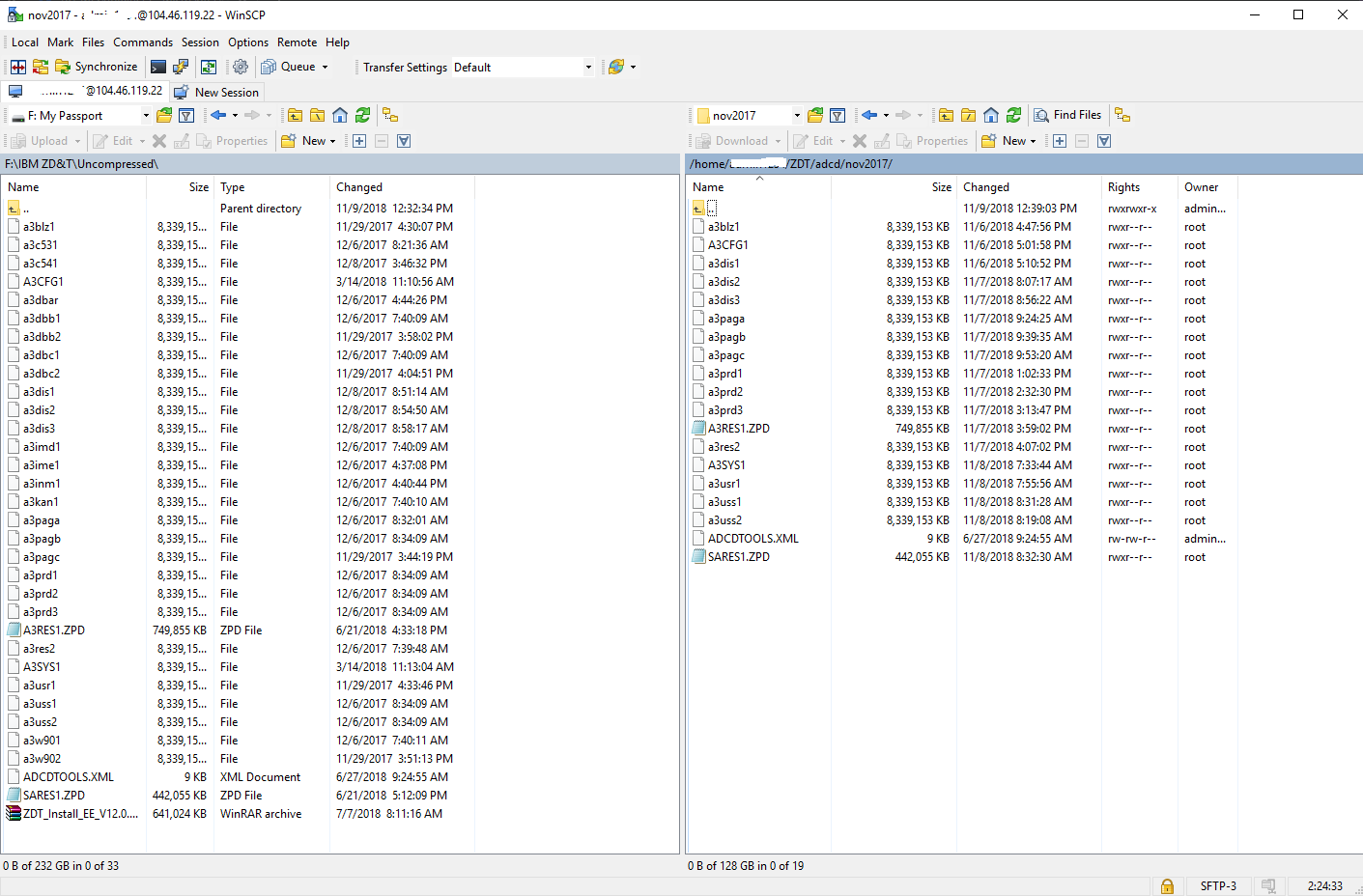
Configure the image storage
The next step is to configure zD&T to use the uploaded package(s). The image storage process within zD&T allows you to mount and use the images. It can use SSH or FTP.
Start the zDTServer. To do this, you must be at the root level. Enter the following two commands in order:
sudo su - /opt/ibm/zDT/bin/startServerNote the URL output by the command and use this URL to access the web server. It looks similar to:
https://(your VM name or IP address):9443/ZDTMC/index.html
Remember, your web access uses port 9443. Use this to log on to the web server. The user ID for ZD&T is zdtadmin and the password is password.

On the Quick Start page, under Configure, select Image Storage.
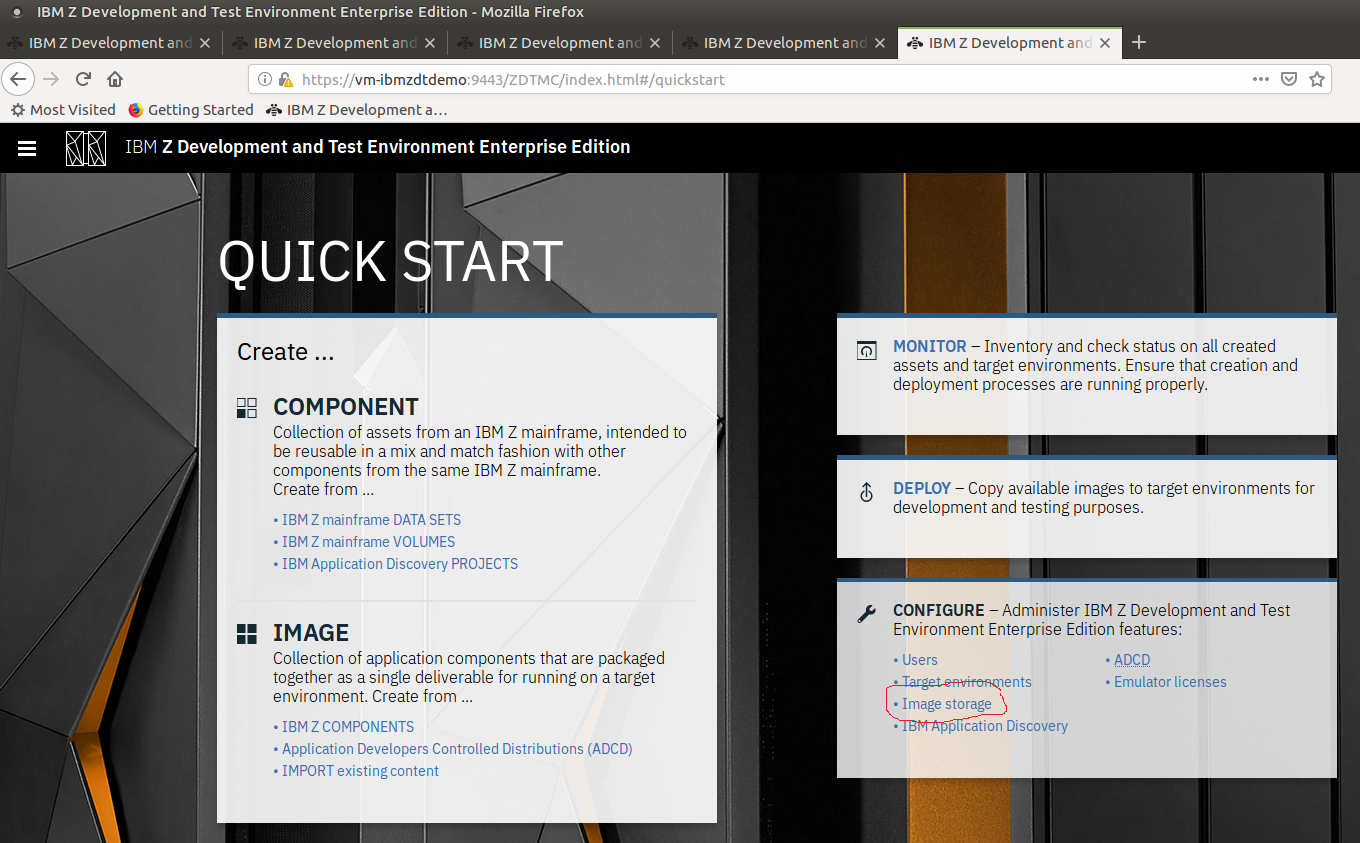
On the Configure image storage page, select SSH File Transfer Protocol.
For Host name, type Localhost and enter the directory path for where you uploaded the images. For example, /home/MyUserID/ZDT/adcd/nov2017/volumes.
Enter the User ID and password for the VM. Do not use the ZD&T user ID and password.
Test the connection to make sure you have access, and then select Save to save the configuration.
Configure the target environments
The next step is to configure the zD&T target environment. This emulated hosted environment is where your images run.
On the Quick Start page, under Configure, select Target environments.
On the Configure target environments page, select Add Target.
Select Linux. IBM supports two types of environments, Linux and Cloud(OpenStack), but this demo runs on Linux.
On the Add target environment page, for Host name, enter localhost. Keep SSH port set to 22.
In the Target Environment label box, enter a label such as MyCICS.
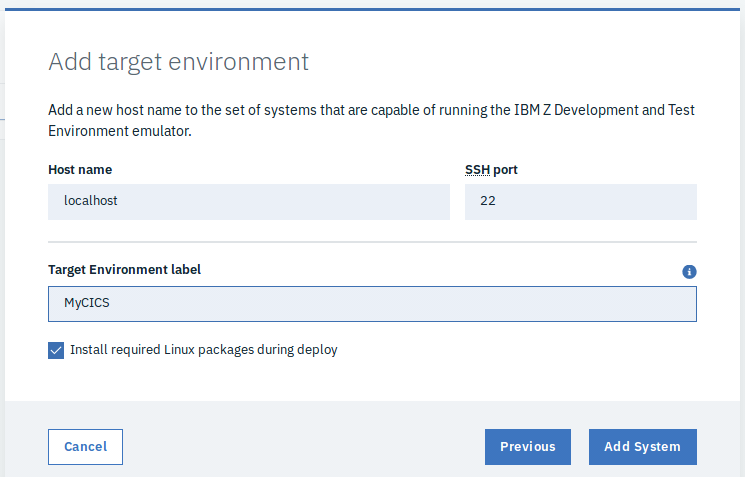
Configure ADCD and deploy
After completing the previous configuration steps, you must configure zD&T to use the package(s) and target environment. Again, you use the image storage process in zD&T, which allows you to mount and use the images. It can use SSH or FTP.
On the Quick Start page, under Configure, select ADCD. A set of instructions appear, telling you the steps that need to be completed before an ADCD package can be mounted. This explains why we named the target directory the way we did earlier.
Assuming all the images were uploaded to the correct directories, click the IMAGE from ADCD link displayed in the lower right (shown in step 7 in the following screenshot).
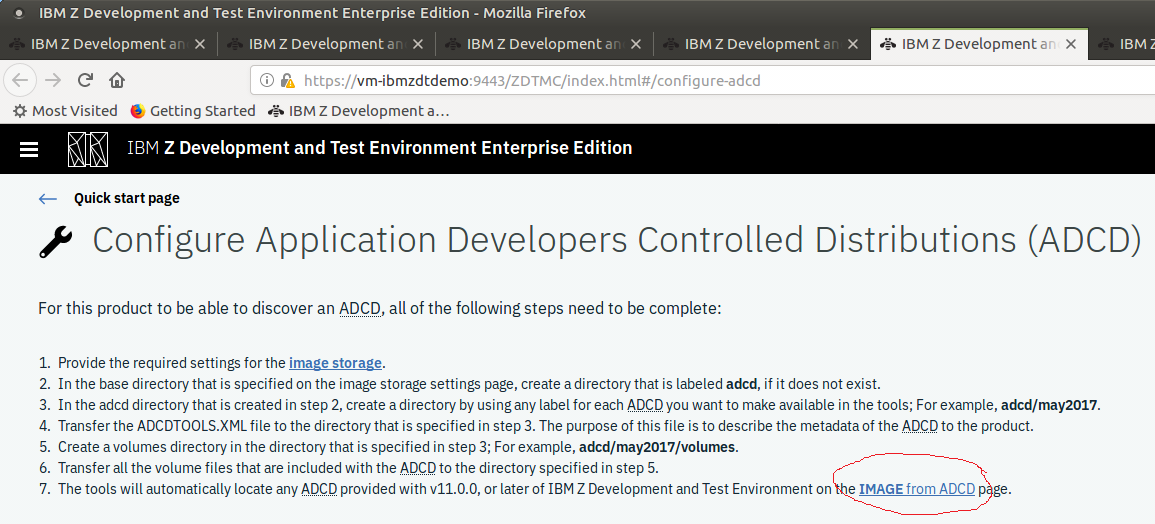
Create the image
When the previous configuration step is complete, the Create an image using ADCD Components page appears.
Select the volume (Nov 2017 in this case) to display the different packages that are in that volume.
For this demo, select Customer Information Control System (CICS) - 5.3.
In the Image name box, type a name for the image such as MyCICS Image.
Select the Create Image button at the lower right.
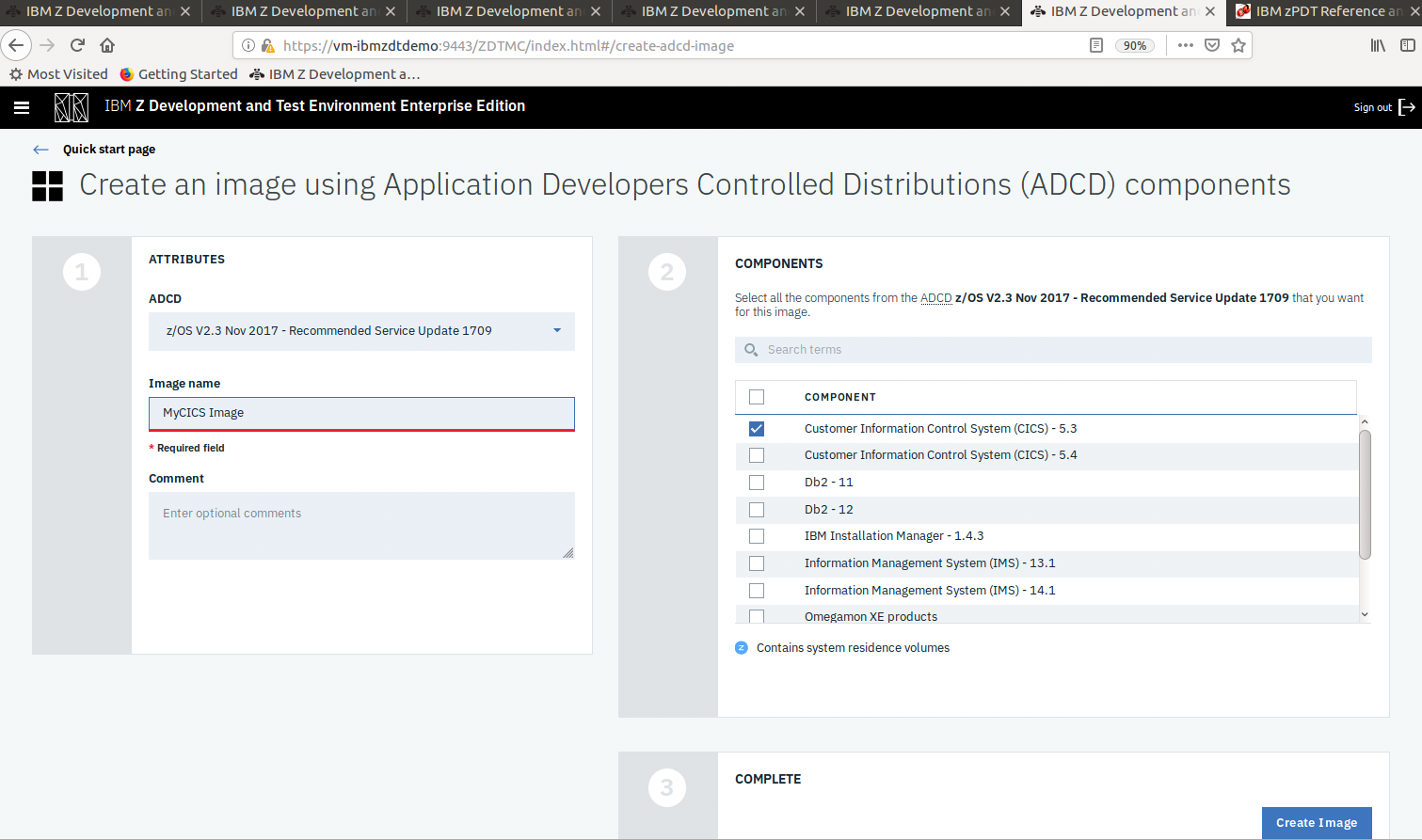
In the window that appears, telling you the image was deployed successfully, choose Deploy images.
On the Deploy an image to a target environment page, select the image you created on the previous page (MyCICS Image) and the target environment created earlier (MyCICS).
On the next screen, provide your credentials for the VM (that is, not the ztadmin credential).
In the Properties pane, enter the number of Central processors (CPs), the amount of System memory (GB), and the deployment directory for the running image. Since this is a demo, keep it small.
Make sure the box is selected for Automatically issue IPL command to z/OS after deploy.
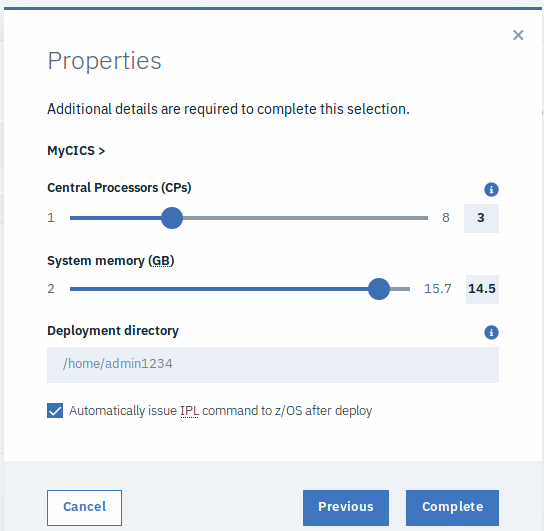
Select Complete.
Select Deploy Image from the Deploy an image to a target environment page.
Your image can now deploy and is ready to be mounted by a 3270 terminal emulator.
Note
If you receive an error saying you do not have enough disk space, note that the region requires 151 Gb.
Congratulations! You are now running an IBM mainframe environment on Azure.